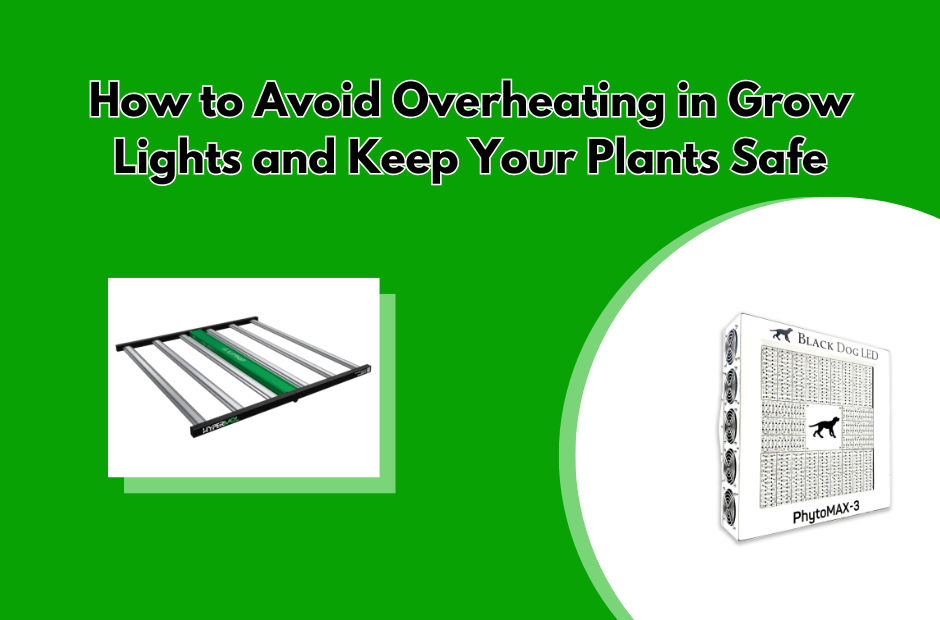
The essential component of hydroponic systems is the best grow lights that ensure plant growth in indoor environments without natural sunlight. Excessive heat generated from grow lights creates negative impacts on plants together with the overall system when no proper management is implemented. This article explains grow light overheating prevention techniques while providing essential temperature control methods for healthy hydroponic plant growth.
Understanding Heat Management in Indoor Growing
The management of heat stands as a critical requirement for successful indoor cultivation. The light-emitting technology of grow lights generates heat energy that builds up within confined spaces when appropriate heat control measures are not implemented. The buildup of excessive heat produces two negative effects on your plants by causing stress and decreasing system efficiency while increasing energy usage.
Hydroponic systems require consistent environmental conditions so plants need proper temperature control. The combination of perfect growing environment factors such as light exposure and temperature maintenance leads to optimal plant health and maximum yield production. High temperatures cause plants to grow slowly while also producing burned leaves and ultimately result in plant death.
Common Signs of Heat Stress in Hydroponic Plants
Too much heat causes heat stress to develop in plants and this produces multiple adverse effects on their health. Heat stress symptoms in plants include the following indicators:
- The lack of proper moisture supply combined with high temperatures will cause leaves to curl or wilt.
- Plants exposed to high heat levels develop yellow or brown leaves because the heat causes chlorophyll loss.
- Heat stress causes plants to grow slowly which results in poor development of their structure.
- The tips of leaves will develop brown discoloration when plants remain in high temperature conditions for extended periods.
- High temperatures cause dehydration and stress which makes plants appear limp and lethargic.
- You must immediately take steps to decrease heat exposure and bring environmental conditions back to their optimal state when you observe these signs.
Essential Cooling Solutions for Grow Light Systems
The control of hydroponic system temperature requires proper cooling solutions to stop overheating conditions. Here are several effective methods:
- Proper Ventilation
- A proper ventilation system should be installed to create airflow around grow lights. The grow area stays free of excessive heat buildup because adequate ventilation effectively removes heat from the space.
- The recommendation involves using oscillating fans together with exhaust fan installation to maintain proper airflow. Active airflow systems effectively reduce the accumulation of heat in the area.
- Heat Shields and Reflectors
Heat shields together with reflectors serve as heat dissipation tools which redirect dangerous heat energy away from plant areas.
The installation of these products will prevent heat from building up in direct contact with plants and their surroundings.
- Water-Cooled Lights
Hydroponic systems that employ water-cooled grow lights exist as a solution to heat management. The lighting system features a water circulation mechanism that draws heat from the light source through its cooling system.
The system represents an optimal solution for big commercial hydroponic facilities because it controls both lighting strength and temperature regulation.
- Air Conditioners or Cooling Units
A cooling system consisting of air conditioning units will manage temperature ranges optimally in bigger hydroponic setups.
The ideal temperature for maintaining both plants and equipment health should be set between 70-75°F (21-24°C).
Best Practices for Temperature Monitoring
Hydroponic plants require constant temperature checks to achieve their optimal environment. These best practices will help you maintain complete control over your temperature system:
- A digital thermometer should be placed at plant canopy height to measure the light-exposed temperature at the same level where plants grow. The temperature measurement needs to be checked multiple times during each day for consistency.
- Real-time data and temperature threshold alerts can be achieved through automated temperature sensors installed into your hydroponic system.
- The relationship between humidity and temperature exists as one factor affects the other. The optimal range for relative humidity should be 50-60% to avoid overheating.
Preventive Maintenance Tips
Your grow lights together with your system need preventive maintenance to operate at maximum efficiency. Here are some key tips:
Regular cleaning of grow lights eliminates both performance-degrading dust accumulation and heat accumulation from grime buildup.
Regular checks of ventilation systems should involve cleaning air filters together with fan inspection to maintain proper airflow.
Regular checks of all system components including fans and pumps and sensors should lead to the replacement of any worn-out parts.
Track your energy consumption because high power consumption may indicate system inefficiencies.
A healthy hydroponic growing environment depends heavily on proper heat management. The knowledge of grow light heat signatures combined with suitable cooling techniques protects plants from overheating. Professional growers and beginners both need to check and modify temperature levels regularly to achieve optimal plant health and production results.








Great tips for maintaining optimal grow light temperatures and protecting plants! Very informative and helpful!